In this review anything that might be considered a spoiler is hidden in a collapsible window with a spoiler alert on it. In all other ways, this review is spoiler-free.
There are many rumours about the Mystery House. It looks like a common abandoned mansion, but very few of those who entered it came back. Some say the house is a portal that leads to hundreds of parallel worlds. Others say it has its own will, that it carries you where it wants to and that you can only come back if you accomplish its wishes.
Mystery House: Adventures in a Box is a cooperative, app-driven game that has one to five players exploring a 3-D “house”, searching for objects and clues to solve riddles and mysteries.
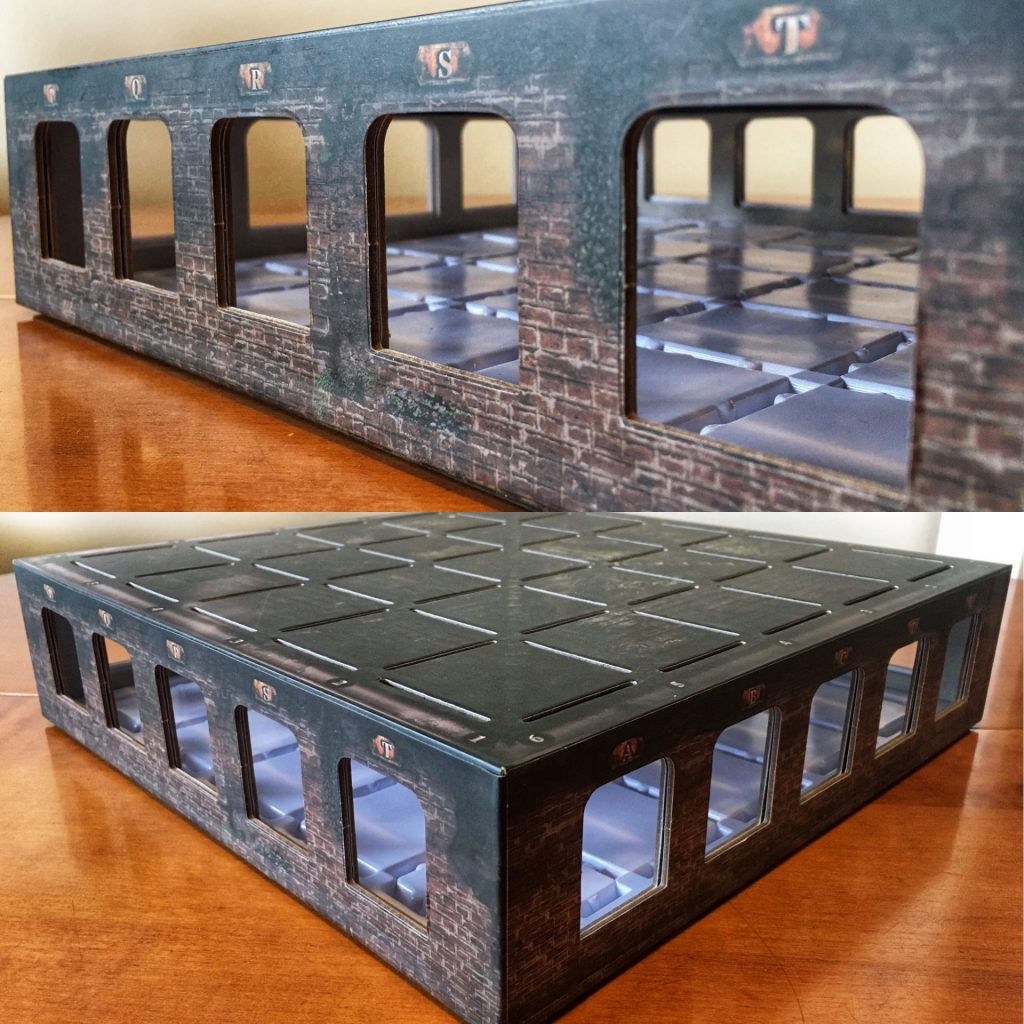
The game itself includes the House structure, which players will explore, and two adventures (Family Portrait and Lord of the Labyrinth), each of which can only be played once (but there is no component destruction).

Game Setup
Each box contains an adventure and all the components needed for it, except for the House structure which is always used. Within the adventure box are Object Cards and Location Cards.
As the game progresses, players will be instructed to take Object Cards when they discover items in the House. The Location Cards, though, create the setting for the adventure. Each Location Card has a letter and a number corresponding to a coordinate on top of the House structure.

Players must insert all the Location Cards into their correct positions before beginning to play the game.

Once all Location Cards have been set up, players begin their adventure by launching it on the Mystery House companion app. The app introduces the story and the players’ objective, as well as begins the 60-minute timer. The app is also used to interact with the House and the objects within it, but first it’s important to understand how the House structure is used.
Exploring The House
As soon as the app timer begins, players are free to explore the House, looking at it from all sides and searching for objects, information, and clues on Location Cards. However, players are only able to examine what can be seen through a window. This means that a player may not remove a Location Card from the structure to observe it more closely. There are no player turns in Mystery House so all of this is done simultaneously.
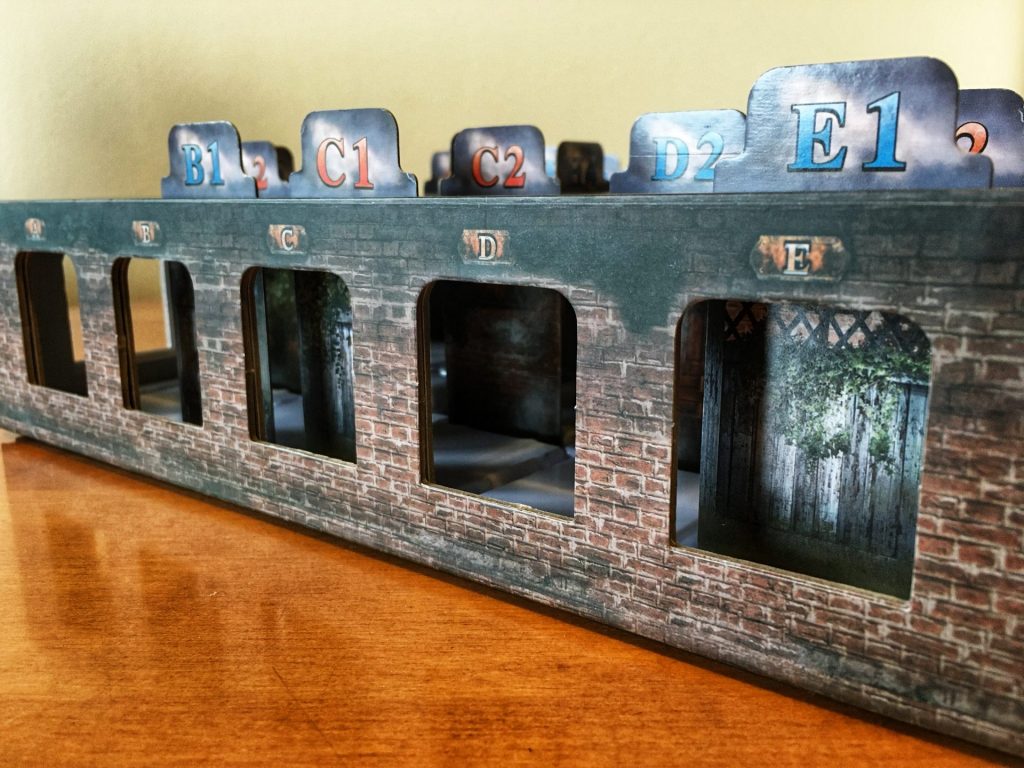
App Interaction
To learn more about an object on a Location Card, players must use the app. By entering the Location Card coordinates (e.g. A1 or C5) and then selecting the object from the list, players might gain useful information.

Sometimes the app simply describes the object, possibly giving a clue, while other times the app might instruct the players to “take” the object (the corresponding Object Card). If players “search” for an object that is not on a Location Card then a 20-second time penalty is given. This prevents players from just clicking on all the objects of a Location Card.
Object Cards – Your Inventory
When players gain an Object Card it becomes part of their inventory. The Objects might simply be used as clues for solving riddles or they could be used to interact with other objects in the House. For example, if you have an axe in your inventory and you later come across a tree, you can try “using” the axe to chop down the tree (note this is not actually an example from the game itself). Using objects is also done through the app. If you are successful the app explains how to proceed; if you are not then you are given another time penalty.
Discovering New Areas
Sometimes players need to enter a code to progress in their adventure (for example, finding a door secured by a combination lock). This, not surprisingly, is also resolved in the app. Get the code right and it describes what happens next, but get it wrong and you are dealt a time penalty.

Occasionally, players gain access to new areas of the House. This happens when the app instructs you to remove Location Cards; these locations won’t be needed again in the adventure. This is great because players generally gain access to new rooms or paths, and sometimes they simply are able to see a Location Card more clearly.
Help and Hints
The app provides two kinds of tips for the adventures: the first is general help, which might give players a location to explore, and the second is a more specific hint on how to solve a puzzle.

The specific hints for a puzzle usually have 3 tiers: the first hint is a general clue about how to proceed, the second is more detailed, and the third often gives the solution.
Completing The Adventure
The game ends after players have solved the final puzzle, even if this is beyond the 60-minute timer. If you’ve been following the story, you’ll know when this is coming because you’ll find you’ve got most of the pieces to the mystery and the pile of Object Cards has dwindled. Once players solve the last puzzle, the app finishes the narrative and scores the player’s adventure. This “score” is simply a compilation of facts: how much time remained and how many general and specific hints were used.
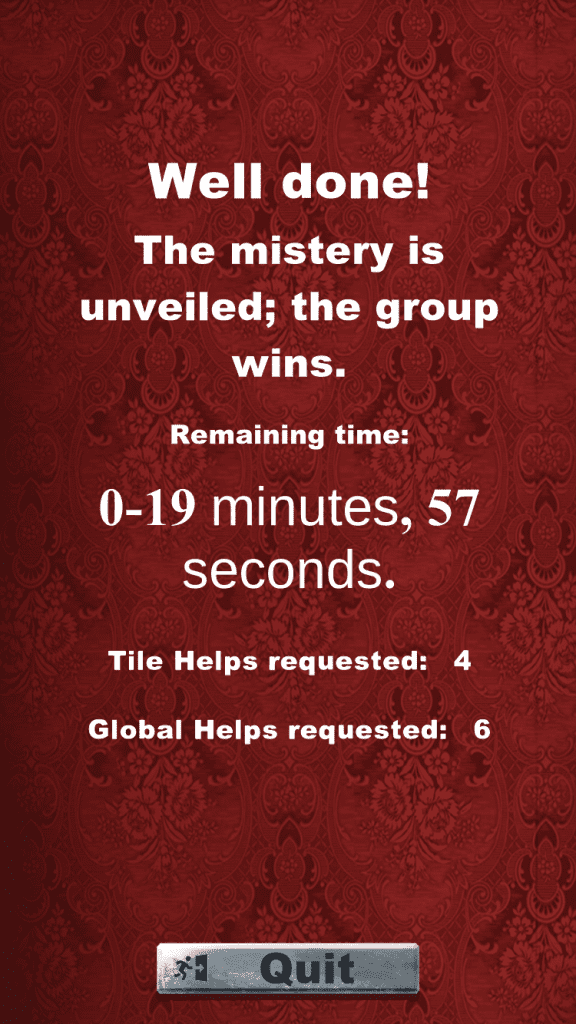
6 Tips to Get the Most Out of Mystery House
- Play Mystery House with four players so that there is one player to manage each side of the House. It is possible to play with fewer, but it is more difficult, especially when it comes to bookkeeping and ensuring every Location Card has been searched well. Playing with five players gets a little too crowded.
- Elevate the House structure on your game table (by using other board game boxes, for example). This keeps players from having to crane forward for a better view.
- Take detailed notes and read the app information carefully. It’s always possible to re-explore areas, but it will waste your time.
- Ensure you set the Location Cards up correctly and punch out any die-cuts on these cards before playing. Have someone even check your work because a misplaced Location Card could mean the entire game is ruined.
- Light is important in Mystery House. Play the game in a well-lit area and give players the option to use flashlights to help them explore dark corners. Your eyes will thank you for taking this strain off.
- There are things in the House that might be visible through a window, but with which you won’t be able to interact because they’re “out of reach”. Take note of these things as they might be useful later in your adventure.

Final Thoughts
Mystery House: Adventures in a Box does something that escape room board games have never done before: it not only blends physical components with a digital experience, but does so by completely immersing you in a 3-D world. You really feel like you are searching an abandoned house in the Family Portrait scenario or exploring a labyrinth in Lord of the Labyrinth. That’s really neat.
Each scenario feels just like an adventure, as you explore locations in search of objects and clues. Mystery House is really more like a hide-and-seek board game scavenger hunt than it is a heavy, puzzle-driven escape room game. That isn’t to say that there are no challenging puzzles, but the focus here is on the adventuring aspect and less so on having players continuously solve difficult puzzles. This is reflected in the final scoring. Unlike escape room games like Unlock! or Exit: The Game, the “score” you’re shown at the end of a Mystery House adventure is simply your elapsed time and the number of hints you took, leaving no tangible way to measure your performance.
Mystery House works as a board game with a digital implement because, while it is primarily app-based, the board game element drives the app so you feel like you’re doing more than just playing a digital game. This also leaves space to create expansion content more easily. However, because this game relies so heavily on the app, the implementation needs to be seamless…and unfortunately for Mystery House, it’s not.
App Obstacles
I won’t go into much detail about some of the obvious problems that can arise with an app-driven board game, namely what might happen if the app is no longer supported. Instead I want to touch on how the Mystery House app tracks information and the problems it faces with its use of language.
Tracking Information
The Mystery House app can be quite helpful since it tracks all the unlocked and discarded Location Cards, and it saves the Object Cards that the players gain throughout the adventure. This makes interacting with objects and locations easier since you aren’t likely to accidentally choose something that should have been discarded, for example. I would have liked to see this kind of tracking incorporated in other ways too. For instance, a “Last Visited” option in the app would have been great, especially since the information you are given appears and then disappears once the device’s screen is touched. During one play, we actually lost a clue because a player had accidentally brushed the screen and the app thought we had dismissed the information intentionally. Our action involved discarding components which meant that we weren’t able to go back and try again.
My biggest complaint with how the app tracks information involves sequence breaking, that is solving puzzles for which you haven’t gained all the necessary information. I solved puzzles in Mystery House out of sequence more than I’ve ever done in all the escape room board games I have played, combined.
To better understand what I mean, let me paint a picture of how my group and I finished the Family Portrait scenario. We were nearing the end of our adventure and we knew how we were supposed to solve the final puzzle, but we were missing one of the four pieces. Tired of searching for it, we decided to take a specific hint. The general hint wasn’t helpful; we already had this information. The second part of the hint was the same so we moved to the third part which gave us the code to input in the app (as we expected it might).
We dismissed the hint screen, hoping to continue exploring for that last piece of information even though we had the solution. As we did so the app automatically brought us to the adventure’s ending screen. We didn’t have all of the required information and we certainly didn’t want to finish our adventure, but the app decided that we should be done because we knew the solution (even though that now meant that we would never know what we should have done to gather that last clue). We had missed a puzzle and then accidentally finished the game simply because we were looking for some guidance.
If the app is programmed to track what objects and locations are uncovered in the game, then why is it not able to track this? Even if this level of tracking was too difficult to develop, then why not have the hints tell you what objects or locations are required to solve a puzzle like the hint system in Exit: The Game? What really makes me scratch my head is that occasionally the hints in Mystery House actually do this—so why not have this be the standard for all specific hints? A little extra care would have gone a long way towards making Mystery House feel like a polished production.
The Importance of Spelling, Grammar, and Editing
The other cause of my frustration came down to language. To begin, it is very clear the adventures have been translated to English. Normally this wouldn’t be an issue for me; just look at most of the Unlock! games which have been translated from French or the Exit games which were translated from German. The difference here is that the Unlock! and Exit games have, in general, been translated well and you can feel the care that was put into the translations as you play through the game. This doesn’t quite feel true for Mystery House. I don’t want to undervalue the work that was put into translating the game for an English audience; I have worked as a translator and it is certainly a tough job. That, however, doesn’t change the fact that the many spelling mistakes and grammatical errors take away from the experience, particularly when they change the narrative.

I feel like I can forgive these kind of errors, even if I don’t like them. But, I have a harder time forgiving language errors and typos that provide misinformation, especially in a hint. If you’re at the point where you need a hint, you’re probably already feeling lost and a little helpless, maybe even frustrated. These kinds of errors have a way of really kicking you when you’re down and significantly increasing your level of frustration.

In one of the adventures, our group wasted 18 minutes between time penalties and searching for something that an app hint had told us to find, only to discover, after searching BoardGameGeek, that there was a typo. Mistakes such as this are unacceptable in an escape room board game, but they are even more inexcusable when the fix is a digital one—a relatively easy fix for a publisher to make in comparison to having to reproduce physical components.
As Meeple Mountain’s self-proclaimed escape room reviewer, I’m a harsh critic when it comes to games in the genre because I’m such a huge fan. I have also played so many at this point that an escape room game needs to be nearly perfect for me to recommend it to other gamers. I had high hopes for Mystery House: Adventures in a Box, but unfortunately it just fell short. To be clear, the source of most of my complaints is the app integration in both adventures and not actually with the game designs themselves. The stories were interesting, the puzzles were challenging, and the 3-D nature of the game feels innovative. Nonetheless, the problems scattered throughout the app for both adventures prevent a seamless experience and, since the gameplay is so app-driven, the game itself suffers as a result.
I still feel like Mystery House: Adventures in a Box has a lot of potential, especially because many of the errors are only app-based. Since finishing my plays of both adventures, there has been an update to the app so I’m hopeful that Cranio Creations is working on resolving them.
Thematic Music for Playing Mystery House: Adventures in A Box
There is music on the Mystery House companion app, but here are two other 60-minute suggestions.
Lord of the Labyrinth
Pan’s Labyrinth OST by Javier Navarrete
Family Portrait
Castlevania (Music from the Netflix Original Series) by Trevor Morris
Songs to remove from your playlist: Tavern Brawl, Alley Fight, and Hunter, Scholar, Soldier.


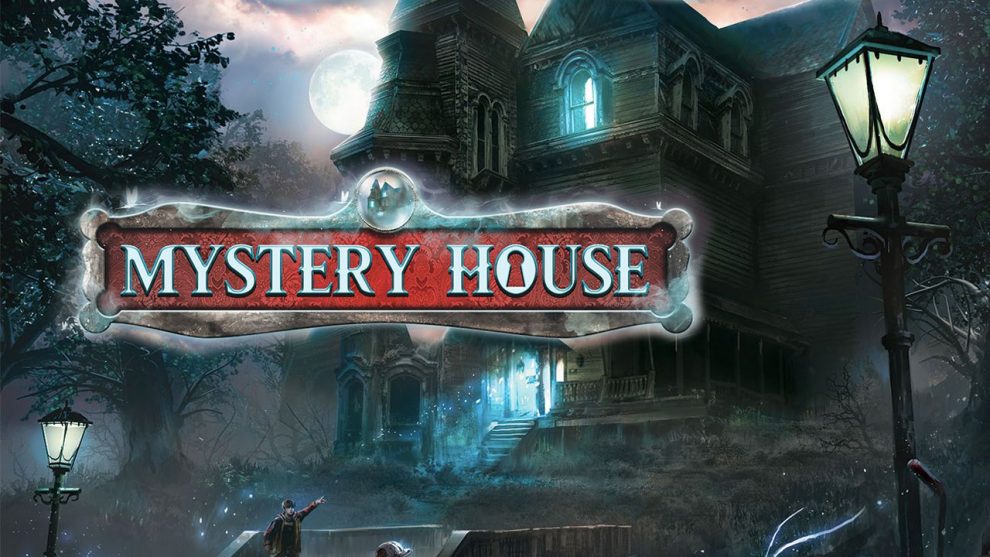


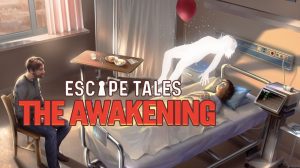





Thanks for the review. This is another game I will avoid.
That’s totally fair. From your comments last week, I’m gathering that you/your group aren’t fans of escape room games to begin with ; )
It is not something that shows up on our radar, to be honest. But I would like to try it. What is the best escape room game out there, in your opinion?
As a complete package, I would say Exit: The Game. I actually wrote a review for the game system and went into detail on each of the first 10 scenarios that were released, as well as a recommended order of play (https://www.meeplemountain.com/reviews/exit-the-game-mega-review-puzzling-out/).
In addition to The Sunken Treasure, The Haunted Roller Coaster and House of Riddles (both of which are not yet in the mega review) are excellent introductory scenarios, specifically because you are solving puzzles linearly.
Cool. I will see if my group will go for it. I would like to give it a shot.
For beginning. Labyrinth ou Portrait ?
I’d suggest Labyrinth (and hopefully the app has been fixed by this point).